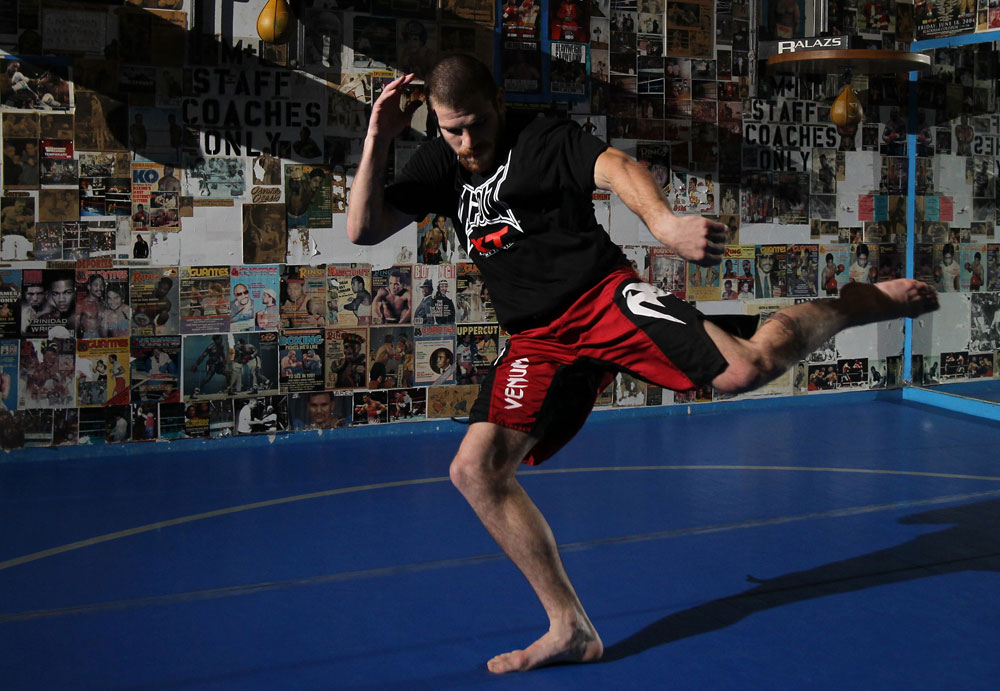
Announcements
UFC fighters have embraced a new way to prepare for training. They don’t stretch, they move.
 When lightweight contender Jim Miller finishes his warm-up, before he begins his strength and conditioning session, he is covered in sweat and breathing like an old-fashioned locomotive. Most people would assume he had just finished his workout rather than just beginning it.
When lightweight contender Jim Miller finishes his warm-up, before he begins his strength and conditioning session, he is covered in sweat and breathing like an old-fashioned locomotive. Most people would assume he had just finished his workout rather than just beginning it.
“I might have Jim do 37 different exercises for the warm-up,” says Martin Rooney, the strength coach for Jim Miller and his brother Dan Miller. “People will say, ‘Warm-up? That was a workout!””
What Miller is doing, and what has become the industry standard for UFC fighters and pro athletes of all stripes, is known as a dynamic warm-up. It is the theoretical opposite of holding a touch-your-toes pose for 30 seconds. Fighters have jettisoned that practice long ago and weekend warriors and gym-goers should follow suit.
“A dynamic warm-up is one of the best things you can do to set yourself up for a good workout,” says Rooney, who has trained Frankie Edgar, Renzo Gracie, Ricardo Almeida, and a slew of high-level grapplers and judo players. “First and foremost, it prevents injuries. During a dynamic warm-up you increase heart rate, increase bloodflow to the muscles, increase nervous system stimulation, and increase coordination and motivation. These are all things that will set the tone for the workout that is coming.”
A dynamic warm-up consists of a series of bodyweight moves that are performed in a circuit fashion and push joints to the threshold of their mobility, but no further. Some of them are good old-fashioned calisthenics set at a higher tempo. The pace is fast, but no extra weight is used. An athlete might go from lunges to arm circles to side shuffles in the span of a minute or two. What you won’t do is hold a muscle in a stretched position, known as static stretching, the way you might have in grade school P.E. class.
For fighters, static stretching has gone the way of the kata. That’s because when a muscle is stretched it loses some of its spring, which is how an athlete generates power. If you constantly stretch a rubber band, it will get longer, but it will also lose some of its snap. A muscle is the same way. A dynamic warm-up prepares the muscle but doesn’t sacrifice any of it explosiveness. A study published in the Journal of Sport Sciences* showed that the rate of force a muscle can produce is reduced by eight percent after traditional static stretching.
“If you have a steak that comes right out of the freezer and you bend it, you’ll rip it,” says Rooney, the author of Warrior Cardio. “But if you get that steak nice and warm, it will be pliable and it can move. A muscle that is warmer and with more bloodflow can conduct nerve impulses faster and is able to generate more force and speed.”
While multiple scientific studies have shown how a dynamic warm-up improves performance, its greatest value lies in its ability to decrease the risk of injury. Research published in the Strength and Conditioning Journal** showed that athletes who dynamically stretched had fewer injuries than those who statically stretched.
“The jury is out on whether dynamic stretching or static stretching is more effective for improving flexibility, but the jury is not out about the fact that static stretching shuts down your nervous system, creates microscopic tears in muscles, and curbs performance. It is the last thing you want to do before a workout,” says Rooney.
Whether you are doing a strength-building 5x5 session in the squat rack, some CrossFit-style metabolic circuits, or rolling on the mats in a grappling class, a dynamic warm-up can help ensure that you have an effective and constructive training session. Best of all, you don’t need to perform 37 different exercises the way Jim Miller does.
“A regular person can do 10 to 12 exercises and get a lot of benefit out of that. It can be done really quickly, in about eight to 10 minutes,” says Rooney. “Just make sure you crack a good sweat. If you don’t you are probably not warmed up.”
Sample Dynamic Warm-Up:
Variations on the dynamic warm-up are limitless. Here is a sample warm-up with familiar exercises that can easily be performed in any type of open space.
Cardio 5 min
Lunges 20 per leg
Running Butt Kicks 20 per leg
Leg Raise 20 per leg
High Kick 20 per leg
Hacky Sack 20 each side
Jumping Jacks 30 total
Side Bends 20 each side
Arm circles 20 each direction
Side shuffles 20-30 yards
Bear Crawl 20-30 yards
High Knees 20-30 yards
Band Pull-Apart 20 total
References:
* Rosenbaum, D. and E. M. Hennig. 1995. The influence of stretching and warm-up exercises on Achilles tendon reflex activity. Journal of Sport Sciences vol. 13, no. 6, pp. 481-90
http://www.ncbi.nlm.nih.gov/pubmed/8850574
** Mann, Douglas, Jones Margaret 1999: Guidelines to the implementation of a dynamic stretching routine, Strength and Conditioning Journal:Vol 21 No 6 pp53-55


